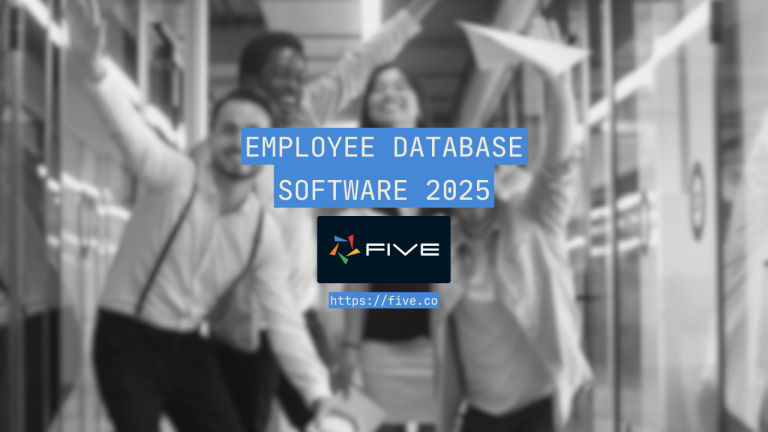AWS Honeycode Is Dead. What are Alternatives?
AWS Honeycode Is Shutting Down. What Are Good Alternatives?
In 2020, AWS launched its brand-new no-code app builder Honeycode to great fanfare. But just three years later, AWS announced that Honeycode is shutting down and will be discontinued, effective February 29, 2024.
The official announcement on the Honeycode website marks the beginning of the end for AWS’ no-code app builder.

For those who have developed apps on AWS Honeycode, the question now is: what’s next? What platform should you migrate to?
Rapidly Develop Modern Web Apps
There are plenty of no-code/low-code tools in the market. A good starting point is understanding each tool’s pricing model. With Five, applications can be deployed to the web for as little as US$29.99 per app and month, including unlimited end-users.
Migrating Away From AWS Honeycode
Step 1: Move Your Data Out of Honeycode
First up, before you even start considering Honeycode alternatives, make sure to download your data stored in Honeycode.
Honeycode has officially announced that all data will be deleted on April 30, 2024, so there’s still time. But it’s always better to be safe than sorry!
To export your data, use the “Export Data” option under your workbook settings in Honeycode. Honeycode will then provide you with CSV files containing your data. For more detailed instructions on how to do this, visit the Honeycode user community here.
Step 2: Find Honeycode Alternatives
Users enjoyed Honeycode because of its Excel-like interface and intuitive, visual interface builder. However, some users also highlighted shortcomings of Honeycode (which might explain its demise), such as:
- The inability to connect to external data sources, or to build on a relational database.
- The limitations on rows per workbook. Honeycode offered a free plan, but it was capped at just 2,500 rows in a workbook. Even its paid plan at US$19.99 per month includes only 10,000 rows.
- The limited functionality of the tool. Honeycode was extremely visual and Excel-like, which was a draw for anyone new to development, but also created limitations for application complexity.
Honeycode was ultimately AWS’ response to solutions such as Google’s AppSheet. But, just like AppSheet, it suffers from many of the same limitations that naturally come from building applications on top of a spreadsheet, instead of a database.
So, let’s explore slightly more professional alternatives within a similar price range as Honeycode.
Five: A Honeycode Alternative
Five is an AWS Honeycode alternative for all those who want to run their applications on a more professional and scalable tech stack.
Applications built with Five come with a MySQL database. If you’re not quite sure what this means: MySQL is the world’s most popular open-source database. It can handle data volumes surpassing 2,500 or 10,000 records easily.
The only prerequisite for setting up a MySQL database is an understanding of relational databases. Unlike a spreadsheet, MySQL or any other relational database, stores data in a relational format for greater efficiency, scalability, and data integrity.
Five has a visual database designer, which makes this process accessible even for those new to database design. On top of that, Five lets you import data stored in CSV easily using its “Import CSV” feature. This makes the process of moving data off Honeycode and into Five seamless.
Five also provides its users with a pre-built application front-end. So unlike in Honeycode, developers do not need to spend time creating a custom user interface. Five’s pre-built user interface is ideal for creating any kind of business software application, such as:
- Human resource applications that manage the onboarding of teams, or manage their availability and shift assignments,
- Approval processes that streamline workflows, or automate tasks, using email and in-app notifications,
- Asset management applications that help users keep track of inventory,
- Surveys that gather feedback from customers, employees and events, or
- Budgeting and event management applications to plan and keep track of time and cost.
Find a wide variety of template applications on our website here.
Last, Five makes it easy to give access to applications. By simply switching on the “multi-user” setting, applications are automatically turned into login-protected apps that allow for the creation of unique user accounts. Each application is hosted under a unique URL that can be shared with end-users to access the app.
Five’s features make it an attractive alternative for those migrating away from AWS Honeycode. But features apart, the big question is how much does running an application developed with Five cost? After all, AWS Honeycode didn’t just offer ease of use. It was also very affordable.
So, let’s take a closer look at Five’s pricing next.
Five: How Much Does It Cost to Build and Run an Application?
Many Honeycode users liked the simplicity and affordability of its pricing model, starting at just US$19.99 per month.
Five offers equally affordable pricing, starting at just US$27.49 per application and month. Now, this is arguably slightly more expensive than Honeycode, but there’s no limit on records or users. On top of that, Five is also free to download, so developers can build and test their applications locally free of charge.
Building Your First App with Five
To build your first app with Five, follow our beginner-friendly Excel to Web App tutorial.

